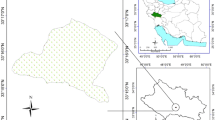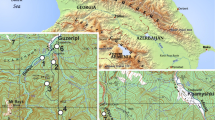Abstract
We studied rattan communities in four forest types in Borneo and Java to clarify the pattern of species diversity and vegetation structure. Within six plots of 4.82 ha in total, we found 42 rattan species in six genera with 4,736 stems (≥20 cm long). There was a significant positive correlation between rattans and trees in species diversity, decreasing in the order mixed dipterocarp (for rattans: Shannon–Wiener diversity index, H′ = 2.87–3.34) > alluvial (1.96) > lower montane (1.43) > peat swamp forests (1.34). This pattern coincided with the diversity of the regional flora. The density of rattan stems (ha–1) decreased in the order lower montane (5,997) > mixed dipterocarp (598–992) > alluvial (592) > peat swamp forests (162). The maximum height of rattans would be determined by the canopy height, rather than by the maximum tree height. The rattan stem volume ranged from 0.25 to 1.88 m3 ha−1 and was not correlated with the stem density. The cool montane climate seemed to decrease the maximum height of rattans, and a few small rattans made denser colonies. Swampy environments apparently suppressed the survival of non-climbing rattans strongly, but that of tall climbing rattans less so.




Similar content being viewed by others
References
Aiba S, Kitayama K (1999) Structure, composition and species diversity in an altitude-substrate matrix of rain forest tree communities on Mount Kinabalu, Borneo. Plant Ecol 140:139–157
Appanah S, Gentry AH, LaFrankie JV (1993) Liana diversity and species richness of Malaysian rain forests. J Trop For Sci 6:116–123
Bogh A (1996) Abundance and growth of rattans in Khao Chong National Park, Thailand. For Ecol Manage 84:71–80
Burnham RJ (2002) Dominance, diversity and distribution of lianas in Yasuni, Ecuador: who is on top? J Trop Ecol 18:845–864
Condit R, Sukumar R, Hubbell SP et al (1998) Predicting population trends from size distributions: a direct test in a tropical tree community. Am Nat 152:495–509
Dransfield J (1978) Growth forms of rain forest palms. In: Tomlinson PB, Zimmermann MH (eds) Tropical trees as living systems. Cambridge University Press, New York, pp 247–268
Dransfield J (1979) A manual of the rattans of the Malay Peninsula. Forest Department Malaysia, Kuala Lumpur
Dransfield J (1984) The rattans of Sabah. Forest Department, Sabah
Dransfield J (1992a) The ecology and natural history of rattans. In: Mohd WRW et al (ed) A guide to the cultivation of rattan. Forest Research Institute Malaysia, Kuala Lumpur, pp 27–33
Dransfield J (1992b) The rattans of Sarawak. Royal Botanic Gardens Kew & Sarawak Forest Department
Dransfield J (1992c) The taxonomy of rattans. In: Mohd WRW et al (ed) A guide to the cultivation of rattan. Forest Research Institute Malaysia, Kuala Lumpur, pp 1–10
Dransfield J (1997) The rattans of Brunei Darussalam. Forestry Department Brunei Darussalam and Royal Botanic Gardens Kew
Dransfield J, Manokaran N (eds) (1994) Plant resources of South-East Asia. No. 6. Rattans. Procea Foundation, Bogor
Dransfield J, Patel M (2005) Rattans of Borneo: an interactive key. Royal Botanic Gardens, Kew (CD-ROM)
Gehring C, Denich M, Vlek PLG (2005) Resilience of secondary forest regrowth after slash-and-burn agriculture in central Amazonia. J Trop Ecol 21:519–527
Gentry AH (1991) The distribution and evolution of climbing plants. In: Putz FE, Mooney HA (eds) The biology of vines. Cambridge University Press, Cambridge, pp 3–49
Grubb PJ, Lloyd JR, Pennington TD et al (1963) A comparison of montane and lowland rain forest in Ecuador. 1. The forest structure, physiognomy, and floristics. J Ecol 51:567–601
Horiuchi H, Suzuki T (1999) Gunung Halimun National Park Mesh Map. JICA, Bogor
Kalima T, Sutisna U (1998) The rattan diversity and its existence in Pameungpeuk Mount, on Mount Halimun National Park, West Java. Bul Pen Hutan 616:27–38
King DA (1990) Allometry of saplings and understorey trees of a Panamanian forest. Funct Ecol 4:27–32
Kohyama T (1987) Significance of architecture and allometry in saplings. Funct Ecol 1:399–404
Kohyama T (1993) Size-structured tree populations in gap-dynamic forest – the forest architecture hypothesis for the stable coexistence of species. J Ecol 81:131–143
Kohyama T, Suzuki E, Partomihardjo T et al (2003) Tree species differentiation in growth, recruitment and allometry in relation to maximum height in a Bornean mixed dipterocarp forest. J Ecol 91:797–806
Lieberman M, Lieberman D, Hartshorn GS et al (1985) Small-scale altitudinal variation in lowland wet tropical forest vegetation. J Ecol 73:505–516
Lieberman D, Lieberman M, Peralta R et al (1996) Tropical forest structure and composition on a large-scale altitudinal gradient in Costa Rica. J Ecol 84:137–152
Mori T, Zollfatah AR, Tan CH (1980) Germination and storage of rotan manau (Calamus manan) seeds. Malay Forester 43:44–55
Nabe-Nielsen J, Hall P (2002) Environmentally induced clonal reproduction and life history traits of the liana Machaerium cuspidatum in an Amazonian rain forest, Ecuador. Plant Ecol 162:215–226
Nakamura K, Noerdjito WA, Hasyim A (1994) Regional difference and seasonality of rainfall in Java, with special reference to Bogor. Tropics 4:93–103
Nasi R (1993) Analysis of the spatial structure of a rattan population in a mixed dipterocarp forest of Sabah (Malaysia). Acta Oecol 14:73–85
Richards PW (1996) The tropical rain forest, 2nd edn. Cambridge University Press, Cambridge
Sastry CB (2002) Rattan in the twenty-first century: an outlook. In: Dransfield J et al (eds) Rattan: current research issues and prospects for conservation and sustainable development. FAO, Rome, pp 237–244
Siebert SF (1993) The abundance and site preferences of rattan (Calamus exilis and Calamus zollingeri) in two Indonesian national parks. For Ecol Manage 59:105–113
Siebert SF (2004) Demographic effects of collecting rattan cane and their implications for sustainable harvesting. Conserv Biol 18:424–431
Siebert SF (2005) The abundance and distribution of rattan over an elevation gradient in Sulawesi, Indonesia. For Ecol Manage 210:143–158
Siswanto BE (1991) Rattan inventory method in the Sungai Aya Hulu forest complex, Hulu Sungai forest district, South Kalimantan. Bul Pen Hutan 533:13–22
Soedjito H (1999) Flora dan Fauna Taman National Betung Kerihun Kalimantan Barat (Flora and Fauna, Betung Kerihun Natinal Park, West Kalimantan). WWF Indonesia, PHPH, LIPI, ITTO, Jakarta
Stockdale MC, Power JD (1994) Estimating the length of rattan stems. For Ecol Manage 64:47–57
Tomlinson PB (2006) The uniqueness of palms. Bot J Linn Soc 151:5–14
Uhl NW, Dransfield J (1987) Genera Palmarum. Allen Press, Lawrence, KS, USA
Van Valkenburg JLCH (1997) Non-timber forest products of East Kalimantan: potentials for sustainable forest use. The Tropenbos Foundation, Wageningen, the Netherlands
Watanabe NM, Suzuki E (2007) Ontogenetic development in architecture and biomass allocation of 13 rattan species in Indonesia. J Plant Res 120:551–561
Watanabe NM, Miyamoto J, Suzuki E (2006) Growth strategy of the stoloniferous rattan Calamus javensis in Mt. Halimun, Java. Ecol Res 21:238–245
Whitmore TC (1984) Tropical rain forests of the far east. Oxford University Press, Oxford
Whitmore TC (1998) An introduction to tropical rain forests. Oxford University Press, Oxford
Yamada T, Suzuki E (2004) Ecological role of vegetative sprouting in the regeneration of Dryobalanops rappa, an emergent species in a Bornean tropical wetland forest. J Trop Ecol 20:377–384
Yamada T, Ngakan OP, Suzuki E (2007) Habitat differences between two congeneric canopy trees, Pterospermum javanicum and P. diversifolium (Sterculiaceae) in an Indonesian floodplain forest. Tropics 16:165–169
Acknowledgements
We thank the Indonesian Institute of Science (LIPI) and the Brunei Museum for permission to conduct our research, and Dr Herwint Simbolon, Dr Tukirin Partomihardjo, and Mr Awang Samhan Bin Nyawa for their helpful cooperation. Dr John Dransfield of the Royal Botanic Gardens, Kew, kindly identified our rattan specimens. The study was financially supported by a Grant-in-Aid for Scientific Research (B) No. 12575007 from the Ministry of Education, Culture, Sports, Science and Technology, Japan.
Author information
Authors and Affiliations
Corresponding author
Rights and permissions
About this article
Cite this article
Watanabe, N.M., Suzuki, E. Species diversity, abundance, and vertical size structure of rattans in Borneo and Java. Biodivers Conserv 17, 523–538 (2008). https://doi.org/10.1007/s10531-007-9268-1
Received:
Accepted:
Published:
Issue Date:
DOI: https://doi.org/10.1007/s10531-007-9268-1




